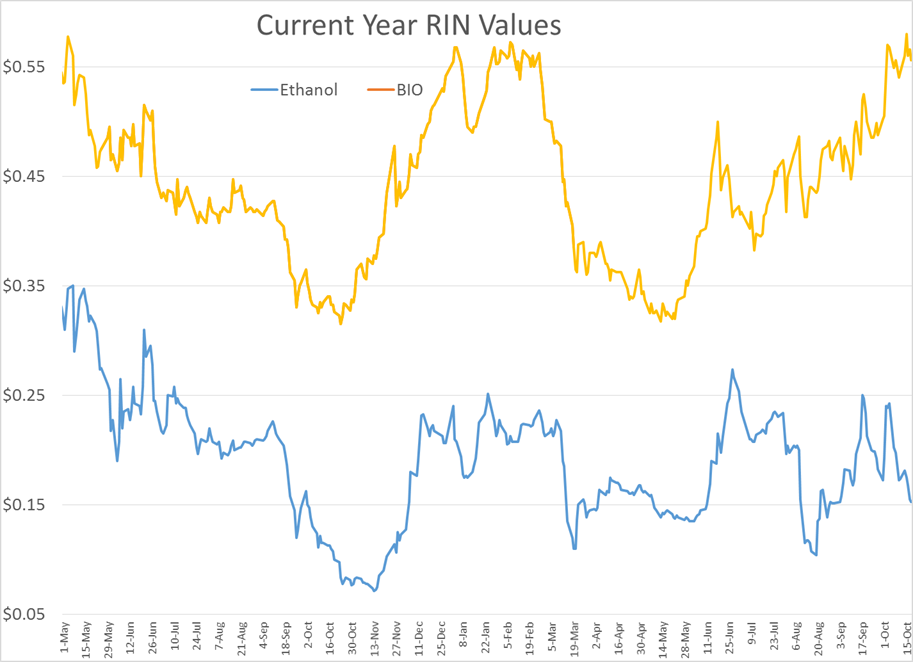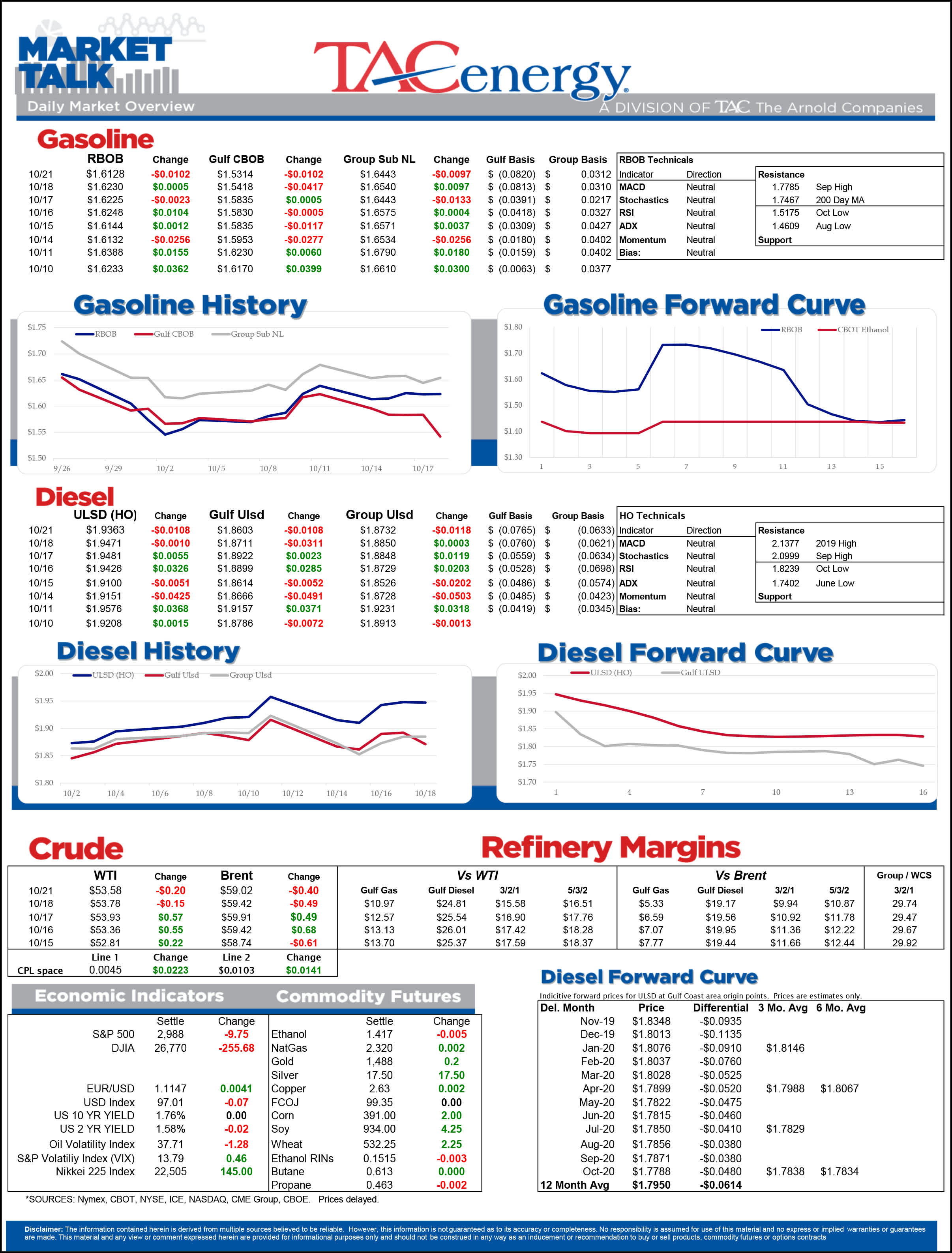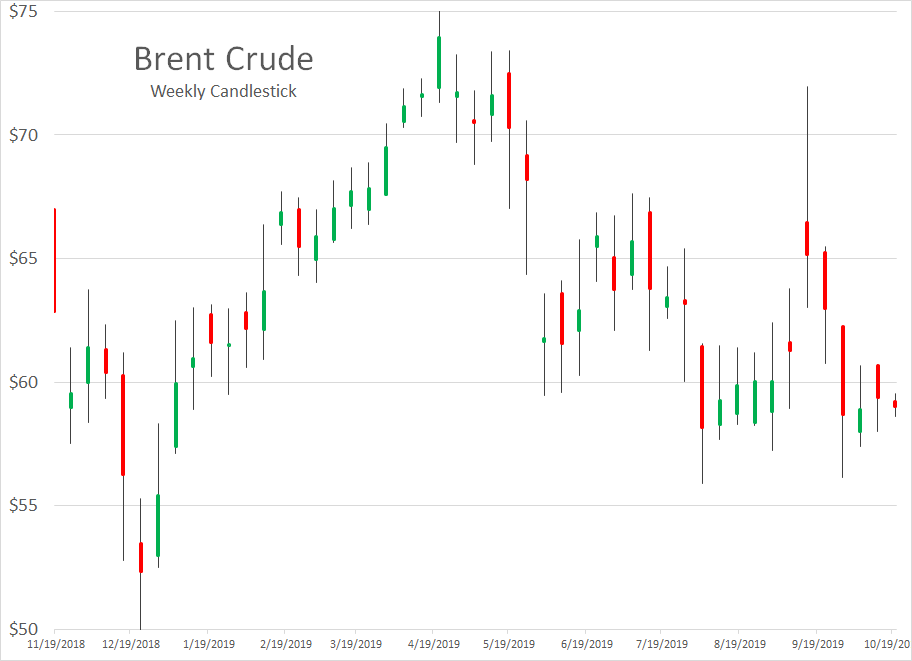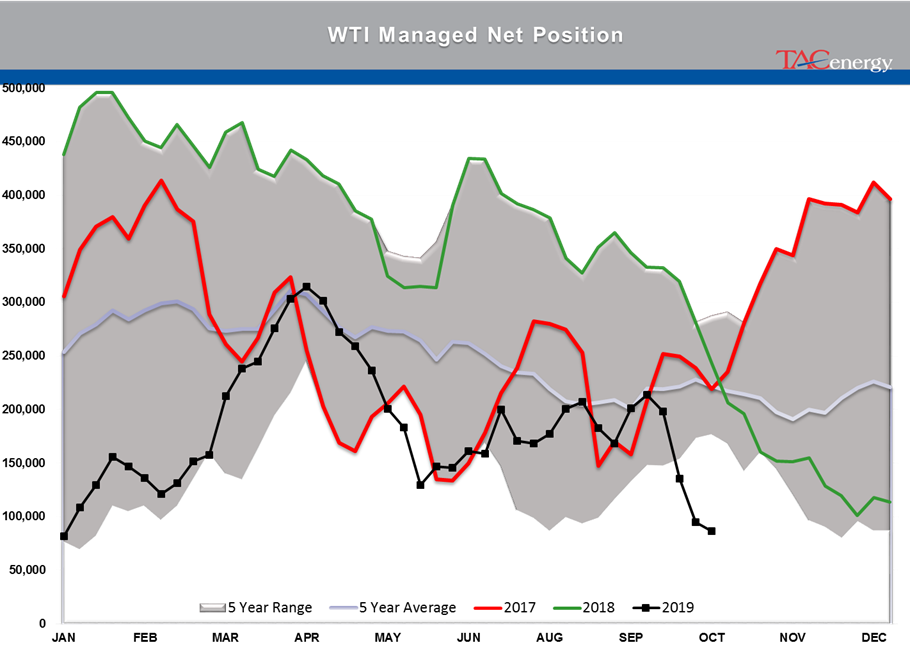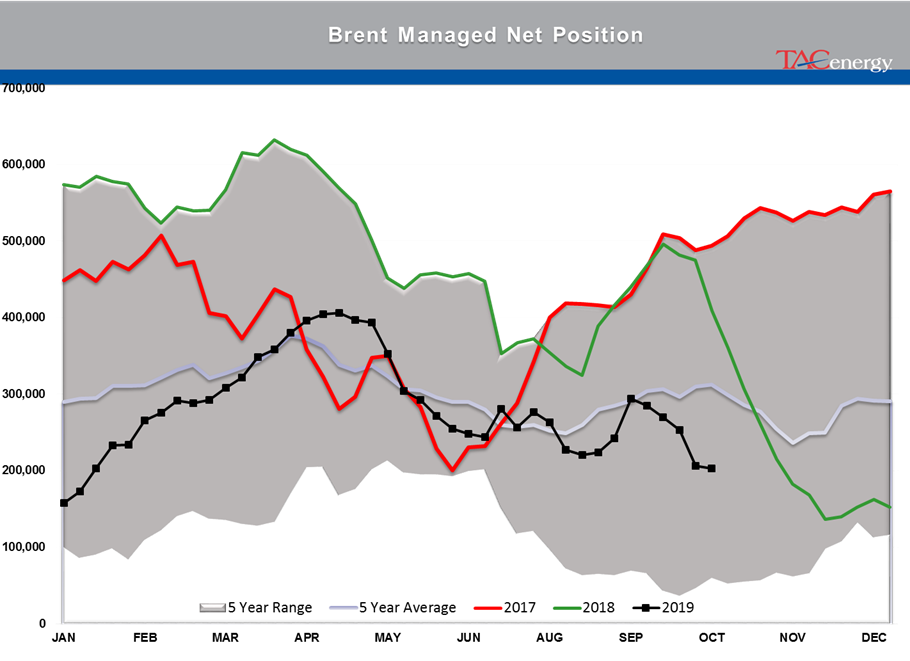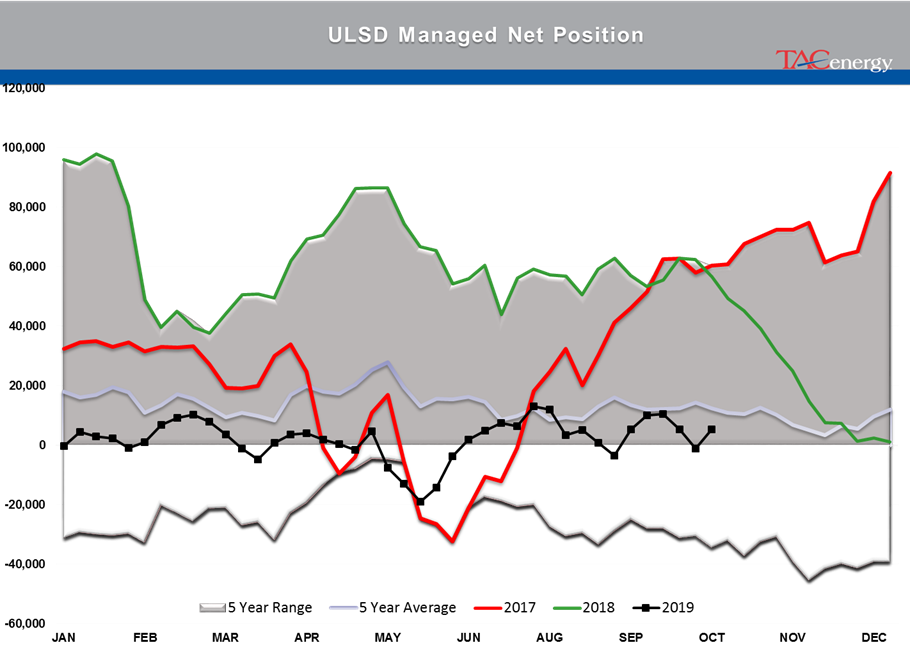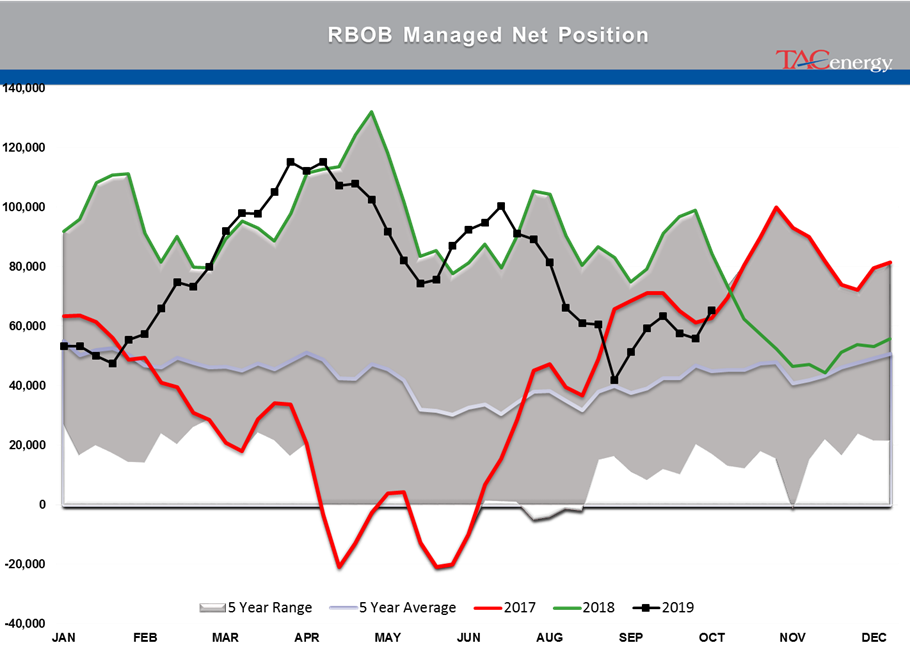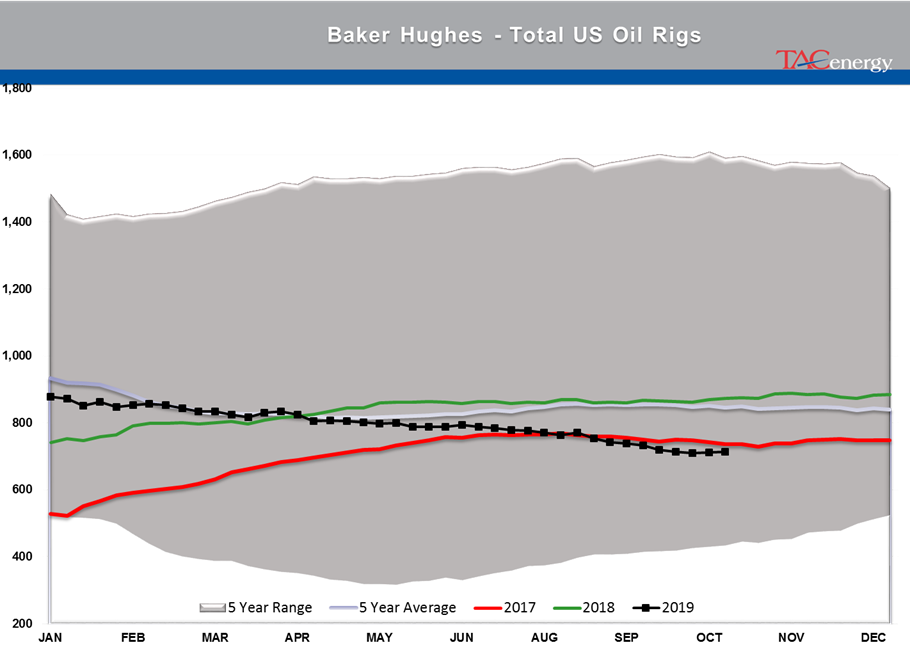Energy Futures are Starting the Week with Modest Losses

Energy futures are starting the week with modest losses, as the complex continues to slog through an extended period of sideways trading. Brent crude prices give a good example of the lethargic trading, as they’ve been stuck between $57 and $62 for 9 of the past 12 weeks, with only the brief price spike following the attack on Saudi oil production moving prices out of that sideways range.
Part of the reason for that lack of action is that money managers are unenthused with energy contracts, with net-length in both WTI and Brent reaching the lowest levels since January. Refined products are also uninspiring in terms of total outstanding positions, but also intriguing as RBOB positions are ticking up towards the high end of their seasonal range, while ULSD positions barely hold onto a positive bias, both counter to seasonal norms as driving slows down and heating demand ramps up.
Baker Hughes reported 1 more oil rig was put to work last week, marking a 2nd week of gains. While adding 3 rigs in two weeks isn’t exactly newsworthy, the two week break from declines does suggest the rig count may have found a temporary floor.
Ethanol RIN values have dropped back to around 15 cents/RIN after trading around 25 cents 2 weeks ago. The EPA’s proposal for spreading renewable volume obligations in the coming years is taking the blame for the latest drop in RIN values.
Click here to download a PDF of today's TACenergy Market Talk.
Latest Posts
Week 17 - US DOE Inventory Recap
The Energy Complex Is Trading Modestly Lower So Far This Morning With WTI Crude Oil Futures Leading The Way
Energy Futures Are Drifting Quietly Higher This Morning
Refined Products Holding Close To Break Even While Oil Prices Are Losing Just Under 1%
Social Media
News & Views
View All
Week 17 - US DOE Inventory Recap

The Energy Complex Is Trading Modestly Lower So Far This Morning With WTI Crude Oil Futures Leading The Way
The energy complex is trading modestly lower so far this morning with WTI crude oil futures leading the way, exchanging hands $1.50 per barrel lower (-1.9%) than Tuesday’s settlement price. Gasoline and diesel futures are following suit, dropping .0390 and .0280 per gallon, respectively.
A surprise crude oil build (one that doesn’t include any changes to the SPR) as reported by the American Petroleum Institute late Tuesday is taking credit for the bearish trading seen this morning. The Institute estimated an increase in crude inventories of ~5 million barrels and drop in both refined product stocks of 1.5-2.2 million barrels for the week ending April 26. The Department of Energy’s official report is due out at it’s regular time (9:30 CDT) this morning.
The Senate Budget Committee is scheduled to hold a hearing at 9:00 AM EST this morning regarding a years-long probe into climate change messaging from big oil companies. Following a 3-year investigation, Senate and House Democrats released their final report yesterday alleging major oil companies have internally recognized the impacts of fossil fuels on the climate since as far back as the 1960s, while privately lobbying against climate legislation and publicly presenting a narrative that undermines a connection between the two. Whether this will have a tangible effect on policy or is just the latest announcement in an election-yeardeluge is yet to be seen.
Speaking of deluge, another drone attack was launched against Russian infrastructure earlier this morning, causing an explosion and subsequent fire at Rosneft’s Ryazan refinery. While likely a response to the five killed from Russian missile strikes in Odesa and Kharkiv, Kyiv has yet to officially claim responsibility for the attack that successfully struck state infrastructure just 130 miles from Moscow.
The crude oil bears are on a tear this past week, blowing past WTI’s 5 and 10 day moving averages on Monday and opening below it’s 50-day MA this morning. The $80 level is likely a key resistance level, below which the path is open for the American oil benchmark to drop to the $75 level in short order.
Click here to download a PDF of today's TACenergy Market Talk.

Energy Futures Are Drifting Quietly Higher This Morning
Energy futures are drifting quietly higher this morning as a new round of hostage negotiations between Israel and Hamas seem to show relative promise. It seems the market is focusing on the prospect of cooler heads prevailing, rather than the pervasive rocket/drone exchanges, the latest of which took place over Israel’s northern border.
A warmer-than-expected winter depressed diesel demand and, likewise, distillate refinery margins, which has dropped to its lowest level since the beginning of 2022. The ULSD forward curve has shifted into contango (carry) over the past month as traders seek to store their diesel inventories and hope for a pickup in demand, domestic or otherwise.
The DOE announced it had continued rebuilding it’s Strategic Petroleum Reserve this month, noting the addition of 2.3 million barrels of crude so far in April. Depending on what the private sector reported for last week, Wednesday’s DOE report may put current national crude oil inventories (include those of the SPR) above the year’s previous levels, something we haven’t seen since April of 2022, two months after Ukraine war began.
The latest in the Dangote Refinery Saga: Credit stall-out, rising oil prices, and currency exchange.
Click here to download a PDF of today's TACenergy Market Talk.
